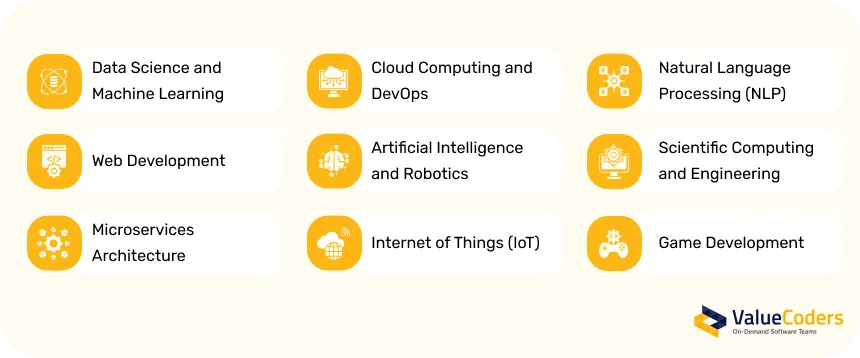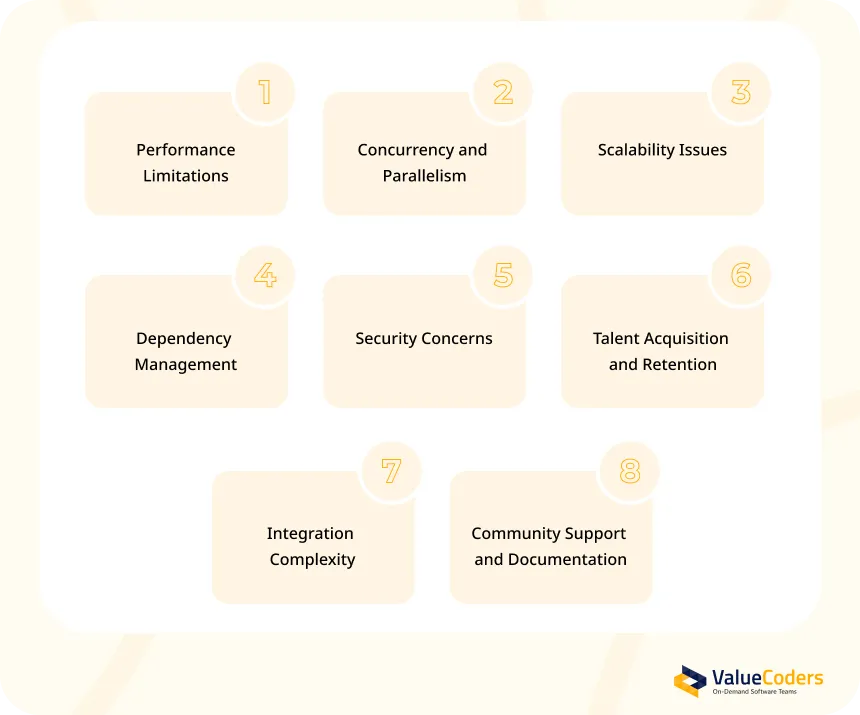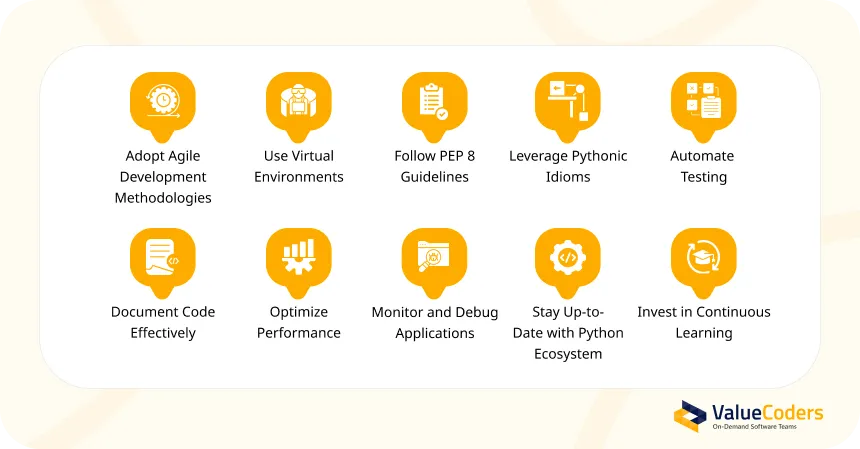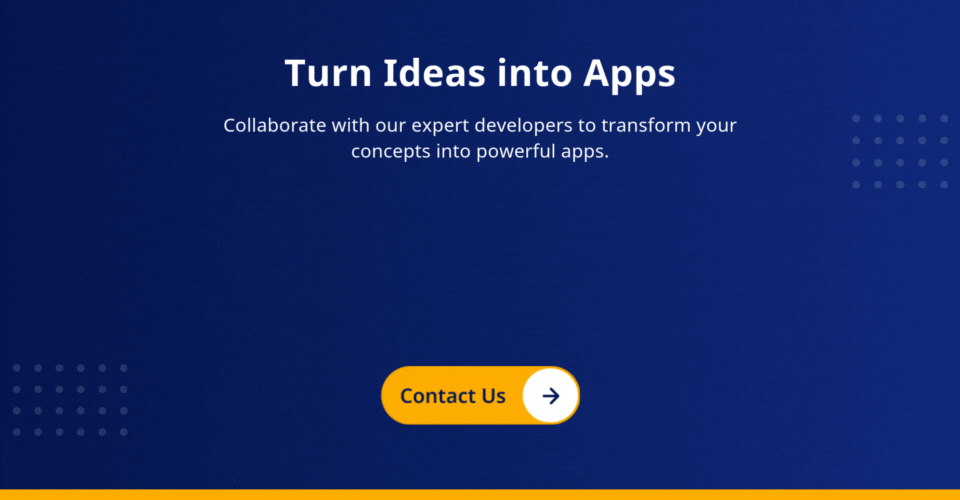Innovation is the foundation of success in today’s rapidly evolving digital landscape.
Python, with its versatility and robust capabilities, has emerged as a driving force behind digital innovation.
In this blog, we’ll discuss the dynamic world of Python and its pivotal role in shaping the future of technology.
From exploring current trends to uncovering practical applications, our goal is to provide valuable insights for businesses and developers alike, including areas such as digital asset management services that benefit from Python’s versatility.
Let’s navigate through the trends, applications, and power of Python, unlocking new possibilities for innovation with Python and growth in the digital world.
Understanding Python’s Role in Digital Innovation
Python development services are crucial for digital innovation because it’s simple, powerful, and versatile.
Anyone can understand its straightforward syntax, no matter their skill level. Plus, there are lots of libraries available for different tasks, like building websites or working on artificial intelligence projects.
Digital innovation with Python offers flexibility that helps developers bring ideas to life faster by letting them test and improve their concepts quickly.
Whether they’re making websites, studying data, or building machine learning models, Python provides the tools to turn ideas into real projects.
In general, the power of Python speeds up innovation by giving developers the tools to solve tough problems and make advancements in different industries without making things too complicated.
Discover how ValueCoders' expertise in Python development can revolutionize your business processes.
Current Trends and Their Practical Applications in Python for Digital Innovation
Python leads digital innovation as it’s simple, versatile, and has lots of libraries and tools.
It’s used in many areas like making websites and working on artificial intelligence, helping to push innovation and progress in different industries.
1. Data Science and Machine Learning
Python for data science is more than just for analyzing data in data science and machine learning. A machine learning development company can make models that predict future trends, automate decisions, and get important information from big sets of data using the power of Python. This Python programming trend helps businesses make smart choices, improve how they work, and bring new ideas to different industries like healthcare and finance.
2. Web Development
Frameworks like Django and Flask make web development with Python easier and let developers make websites that are dynamic and interactive. With the power of Python, developers can add advanced features like letting users sign in, getting updates in real-time, and working with complex databases. This makes websites better for users and helps create new ideas for online services and platforms.
3. Microservices Architecture
Python’s simple and flexible design is perfect for microservices architecture. When developers split digital innovation applications into smaller parts, they can work on them faster, make them bigger or smaller as needed, and change them easily to match what the business needs. This helps businesses come up with new ideas for cloud-based projects and keep up in the fast-changing digital world.
4. Cloud Computing and DevOps
Python is useful in cloud computing and DevOps workflows, where it helps automate tasks like deploying, scaling, and managing applications. Using power of Python for automation helps DevOps teams work faster, make fewer mistakes, and get new features and services to customers quicker. This helps businesses come up with new ideas for cloud-based projects and work more efficiently.
5. Artificial Intelligence and Robotics
Many people choose Python for AI-based projects and robotics because it has lots of useful libraries. With the power of Python, developers can make things like chatbots that use AI or control robots. Python makes it easier to do complex tasks, helping developers come up with new ideas for things like self-driving cars, advanced factories, and robots in healthcare.
6. Internet of Things (IoT)
Python digital innovation is great for making things connected to the internet (IoT) because it doesn’t need much space and works well with small computers. Python software development helps developers offer things like smart homes, factories, and wearable gadgets. Python’s flexibility in IoT helps make new ideas by connecting different devices together and making them work with IoT tools and systems easily.
7. Natural Language Processing (NLP)
Python’s ability to understand human language is helping to make communication and automation better. The power of Python helps developers analyze and understand how people talk, which lets them make new things like tools that understand feelings, translate languages, and chat with people. Python makes it easy for developers to build these tools and use them to make communication better, do tasks automatically, and find useful information in things like emails or social media posts.
Also Read: Java To Python Migration: A Strategic Approach For Modernization
8. Scientific Computing and Engineering
Python’s numerical tools help scientists and engineers study complicated systems, look at data from experiments, and solve math problems. This helps make new ideas and improve how things work in industries like airplanes, cars, and renewable energy. Python gives researchers and engineers ways to deal with challenges and make things better when they’re doing research and development.
9. Game Development
Python is also used to make video games because it’s easy to use and can do lots of different things. With Python, developers can make games that are fun and look great. This helps make new ideas in the gaming world and makes games more exciting for players. Python lets developers make games that push the limits of what people can do in interactive entertainment.
Let ValueCoders' skilled developers take your digital innovation to the next level.
These Python development trends and practical uses show how important Python is for making new things in the digital world.
When developers use the power of Python, they can make creative solutions that solve hard problems and make good changes in today’s digital world.
Challenges for Leveraging Python in Digital Innovation
Although Python is very helpful for coming up with new ideas in digital projects, there are also some problems that organizations might face when using it:
-
Performance Limitations
Python may not be as fast as other languages, especially when doing tasks that need a lot of computer power. Even though Python is easy to use and makes things quickly, organizations might have trouble when they need their programs to run very fast.
-
Concurrency and Parallelism
Python’s Global Interpreter Lock (GIL) can slow down its ability to do many things at once, especially in programs that use lots of threads. This might make programs run slower when they’re supposed to run at the same time. Even though there are ways to fix this, it can still be hard to make Python work well with lots of things happening at once.
-
Scalability Issues
Python might have problems handling really big projects or websites with lots of visitors. Even though frameworks like Django and Flask can help with this, organizations might need to spend extra time and money making their Python programs work well with lots of people using them.
-
Dependency Management
Managing the different parts that Python needs to work can be hard, especially when there are lots of them. Sometimes, different parts might not work well together because they need different versions or don’t work with each other. This can make it tricky to make sure everything works smoothly.
-
Security Concerns
Like all programming languages, Python can have problems with security. To keep things safe, organizations should always check for any problems and update their Python programs and parts regularly. It’s also important to do things like checking the information coming into programs and writing code that’s safe from attacks to protect against any problems.
Also Read:10 Ways Python Development Can Benefit Your Business
-
Talent Acquisition and Retention
Even though more people are using the power of Python, it can still be hard to find people who know it well. Businesses might have trouble to keep and hire Python developers, especially when there are lots of other companies looking for them too.
-
Integration Complexity
Connecting Python with other systems and tools can be hard, especially when there are lots of different things involved. Businesses might have trouble making sure everything works together smoothly when they’re using Python with other programs, databases, or services from other top Python web development companies.
-
Community Support and Documentation
Even though Python has lots of people who use it and a lot of information available, it can still be hard for new developers to find what they need. Businesses might have to spend time helping their developers learn how to use the power of Python well for their projects and give them support along the way.
Even though there are some tough parts, Python is still a really useful tool for making new things in the digital world.
If businesses work on fixing these tough parts and use Python’s strengths well, they can get past the problems and make the most of Python to come up with new ideas and grow.
Partner with ValueCoders to accelerate your digital transformation journey.
Best Practices for Leveraging Python in Digital Innovation
To use the power of Python well for making new things in the digital world, it’s important to follow some good ways of working.
These help make sure projects run smoothly, the code is good quality, and everyone can work efficiently. Here are some important things to do when using Python:
1. Adopt Agile Development Methodologies:
Use flexible ways of working like Scrum or Kanban to help teams work well together, be ready to change, and improve quickly. Divide big projects into smaller jobs that are easier to handle, focus on the most important things first, and check regularly if the work is going in the right direction. This helps make sure everyone’s working towards the same goals and gets the best results.
2. Use Virtual Environments:
Use virtual environments like virtualenv or venv to make separate spaces for Python projects. This keeps things organized and prevents problems when different projects need different things. It also makes sure that the work stays the same from when it’s being made to when it’s being tested and used for real.
3. Follow PEP 8 Guidelines:
Follow the rules in Python Enhancement Proposal (PEP) 8 for writing code that’s easy to read and work with. Make sure to use the same style throughout, give variables names that make sense, and organize the code in a way that makes sense. This helps make sure that everyone can understand and work on the code without any problems.
4. Leverage Pythonic Idioms:
Use Python’s own ways of doing things to write code that’s short, works well, and follows Python’s style. Choose list comprehensions instead of loops, use context managers to handle resources, and use the tools that Python already has to make the code easier to read and run faster. This makes sure that the code is written in the best way for utilizing the power of Python and gets things done quickly and efficiently.
5. Automate Testing:
Use tools like pytest or unit test to automatically check if the code works right. Write tests for small parts of the code, how different parts work together, and how everything works as a whole. This helps make sure the code does what it’s supposed to do, works well, and doesn’t have any problems when changes are made. It also helps with keeping track of changes and making sure everything runs smoothly when putting the code into action.
6. Document Code Effectively:
Write comments in the code that explain what’s happening in a simple and clear way. Use special comments called docstrings to explain what each part of the code does and why it’s there. Make sure all the comments follow the same style, and use tools like Sphinx to make big documents that explain everything about the project in detail. This helps other people understand the code better and makes it easier to work together.
Also Read: Reasons To Choose Python For AI Based Projects
7. Optimize Performance:
Find and fix problems that make the code slow using tools like cProfile or line_profiler. Make parts of the code that are really important work faster, use ways of storing data and doing things that work well, and use tricks to remember results from before to make things faster. This helps the code run better and handle more work without slowing down.
8. Monitor and Debug Applications:
Set up ways to keep an eye on how the program is working and find problems as soon as they happen. Use tools to check what’s happening in the program, figure out what went wrong, and fix any issues quickly. Use special tools to look at the code step by step, check what values different parts of the code have, and find out what’s causing any bugs or problems. This helps make sure the program works well and that any issues get fixed quickly.
9. Stay Up-to-Date with Python Ecosystem:
Stay updated on what’s new and best in the world of Python. Read forums where Python users talk, go to conferences, and join meetings where people talk about Python. This helps you learn about new things, like excellent tools and ways of doing things, that can help you make new stuff in the digital world.
10. Invest in Continuous Learning:
Encourage your team to keep learning and getting better at using the power of Python and other similar technologies. Give them chances to learn new things, share what they know with each other, and try out new ideas. This helps make sure everyone knows a lot and can come up with new and better ways of doing things in the company.
Trust ValueCoders to deliver custom Python solutions that drive growth and success.
By following these best practices of working, businesses can make the most of Python to come up with new ideas in the digital world, make things that work well, and do well in the business world.
Parting Thoughts!
Python stands as a versatile and powerful tool for driving digital innovation across various industries.
Its simplicity, versatility, and extensive ecosystem of libraries and frameworks make it a preferred option for developers seeking to tackle complex challenges and push the boundaries of what’s possible in the digital world.
Python for AI & machine learning to web development, and beyond, the influence continues to grow, shaping trends and driving Python advancements in innovation.
By adopting the power of Python for digital transformation services and following best practices, organizations can unlock new opportunities, streamline development processes, and deliver innovative solutions that drive positive change and propel businesses forward.
As the landscape of digital innovation evolves, staying abreast of emerging trends, leveraging Python’s strengths effectively, and fostering a tradition of continuous learning and experimentation will be key to staying competitive and driving success in today’s fast-paced digital landscape.
Are you ready to leverage Python for your next digital innovation project? Contact us today to learn how ValueCoders can help you harness the power of Python and drive innovation in your organization.
Contact us today to learn how ValueCoders can help you leverage Python for your next digital innovation project!









